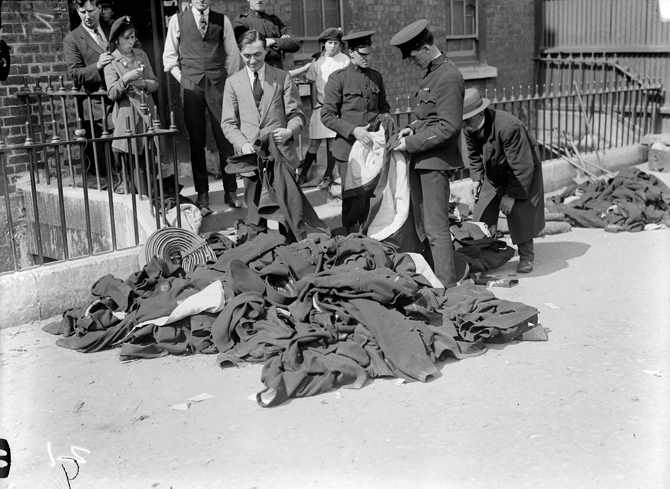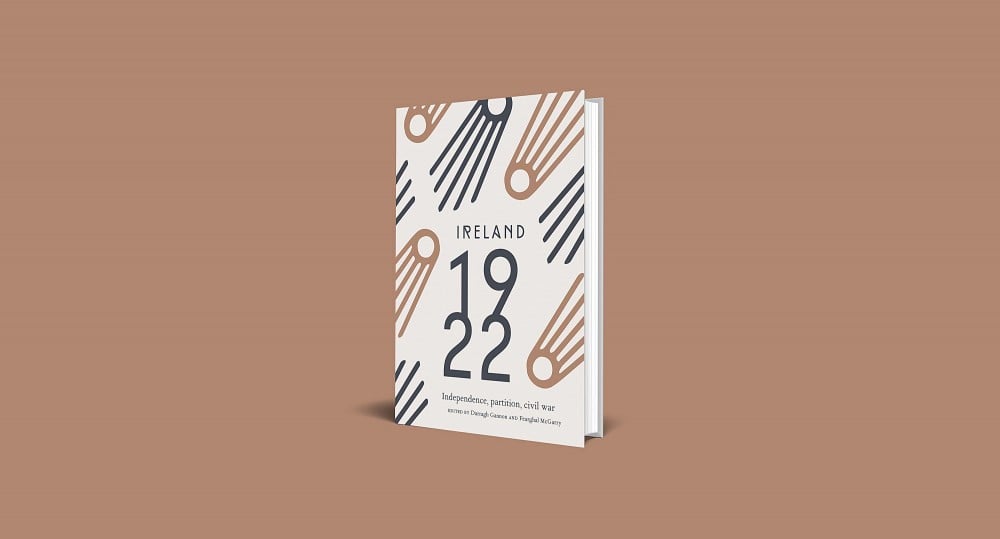17 August 1922: The Disbandment of the Royal Irish Constabulary
Revolutionary Losers: Southern Irish Loyalist Experiences of Migration
By Brian Hughes
On 17 August 1922 Joseph Cashman photographed a small crowd of men and women outside Dublin Castle. Three were in Royal Irish Constabulary (RIC) uniform, with two standing among the discarded jackets and trousers of their colleagues. Less dramatic, perhaps, than men marching in formation, formal salutes, or flags being lowered and raised, the photograph nonetheless captures a symbolic moment in the shift to the new order in the Irish Free State. At 12 o’clock that day, the new Civic Guard (later An Garda Síochána) took charge of Dublin Castle and the RIC was, as The Irish Times put it, ‘fairly disbanded and put into civil life’.¹ The process had begun in April, with men gathered in central barracks and camps before being gradually dispersed. For these former policemen and their families, the consequences lasted well beyond the five months or so it had taken to dismantle the RIC.
A majority of the Irish-born members who remained in the force by 1922—whose numbers included some of the Black and Tans recruited from 1920—stayed in Ireland (on both sides of the new border) and attempted to settle into ‘civil life’. Further policing opportunities were available in the Royal Ulster Constabulary, but among a couple of hundred ex-RIC listed in a Civic Guard register in 1922 and 1923 (by which time recruitment of ex-RIC seems to have effectively ceased), only nine were disbanded men. The remainder had retired, resigned or been dismissed from the RIC by 1921, with some subsequently joining the Irish Republican Army.² As Seán William Gannon has found, a large minority—over one-third—chose to leave Ireland, either temporarily or permanently.³
Individual motivations are difficult to disentangle, but this migration took place in the context of what British civil servant Andy Cope described as a ‘concerted movement for a wholesale expulsion’ of ex-policemen and their families. While this was ultimately something of an exaggeration, and violence and intimidation was sporadic and localised, threats, raids and shooting were regularly reported.⁴ On the night of 25 April 1922, for instance, five armed and masked men entered the home of ex-Sergeant Michael Flynn and ordered him to leave within 48 hours. His family had already packed for a move to Castletownbere, County Cork, but shortly after arrival there they received another letter ordering them to leave. Flynn immediately travelled to Dover, followed five days later by his wife Annie and six young children. Annie Flynn, he later claimed, had received ‘such a fright that she is not the same since’. Finding ‘no prospect of employment’, and with a pension that was ‘not sufficient to meet my demands’, Flynn had returned to Cork by 1924. In 1930 he was living in Bandon, unemployed, and claimed to have ‘no other means of getting the money as Ex R.I.C. men wont [sic] get any employment on account of remaining in the force until disbandment’. The last recorded details in Flynn’s post-disbandment file—the only one of its kind to survive—were unsuccessful applications to have a portion of his pension commuted to pay off some debts, replace a cow that had died and purchase a pony and trap to bring his children to school.⁵
Such challenges were also shared by many of the southern loyalists who left Ireland around 1922, whether because of violence, intimidation, economic concerns, or personal preference. Neither leaving nor returning offered any guarantees. The exact scale of the ‘exodus’ is difficult to discern. In May 1922 the British government established an Irish Distress Committee for ‘persons ordinarily resident in Ireland who, for reasons of personal safety, have come to Great Britain and are represented to be in urgent need of assistance’. By March 1923 it had dealt with 7,500 applications for loans or grants, including 5,600 for ‘immediate assistance’ of which 4,330 were approved. Not all of those who arrived in Britain sought aid, but a large proportion of applicants were married men with wives and children. Nor were these ‘refugees’ all Protestant: it was recorded that 598 grants were awarded to Protestants and 1,063 to Catholics between May and October 1922; most, but not all, from the Irish Free State. These included, as the committee’s chairman Sir Samuel Hoare put it, ‘ex-service men, members of the Royal Irish Constabulary, ex-civil servants in our service in Ireland…who cannot return to Ireland’.⁶
While it is problematic to label all Irish members of the RIC as loyalists, Michael Flynn was just one who labelled himself as a southern loyalist when applying for compensation to the Irish Grants Committee in the late 1920s. As a particularly well-documented group, their post-migration challenges are thus illustrative. Periods of separation were common—often much longer than the Flynns’ five days apart—as men travelled alone in search of work and suitable accommodation, which was often difficult to afford in the absence of new employment. Wives were left to settle up affairs and sell off property as best they could, remaining vulnerable to boycotting, threat and harm. British and dominion police forces were extremely reluctant to take on men with service in Ireland and the stigma could extend to other employers, making work difficult to find in Britain (as Michael Flynn discovered). Other ex-RIC who applied to the Irish Grants Committee were similarly living off pensions and creditors well into the 1920s.
That said, the disbanded RIC had access to supports unavailable to other southern Irish loyalist refugees—including retired rather than disbanded RIC—arriving on British shores around the same time. The latter could apply to the Irish Distress Committee or seek aid from the privately funded Southern Irish Loyalists Relief Association (SILRA). Under the terms of disbandment, meanwhile, some 7,000 ‘disturbance allowances’ and 886 ‘separation allowances’ were disbursed to disbanded RIC. Any who felt in danger at home were entitled to a free travelling warrant to move anywhere in Ireland or Britain, and the RIC tribunal granted thousands of small awards in cases of ‘exceptional hardship’. It further facilitated the loading of pensions to allow a man to ‘live and maintain his family without other employment’, and it adjudicated on applications to commute a portion of a pension to emigrate, establish a business, purchase a farm or in some cases a house. The Irish Office also set up an accommodation bureau; local police commissioners were asked to provide any assistance they could, and the government secured a boarding house in London ‘as an emergency measure’ for families with children.⁷ SILRA, founded in July 1922 for ‘the relief of distress amongst the Southern Irish Loyalists’ in Britain, operated its own RIC Relief Committee and claimed to have 4,000 ex-RIC on its books by September (presumably both Irish and British-born).⁸ Ex-RIC interest groups in Britain provided camaraderie through reunion dinners and dances throughout the 1920s.⁹
Ultimately, there was no uniform experience of life after disbandment. Ex-Sergeant Benjamin Stafford told locals that warned him to leave his home in Cavan that he hoped to be ‘as good a Free State citizen as any they had’, but a cold reception from many of his neighbours, a further threatening notice, and damaged property convinced him to leave permanently for County Down. In November 1926 ex-Constable Patrick Meara applied to the Irish Grants Committee for compensation but insisted that ‘If this claim is to go to anything belonging to the Free State, I will forego it at once, as I do not want any wrangling or business of any sort with the Free State’. A colleague grumbled about his own treatment compared to other ‘civil officers of the State’ who remained in the Free State and ‘lived in peace and quietness’.¹⁰ It is, however, the losses and grievances that are most often recorded. Those who did not suffer or put themselves forward as victims, living quiet and ordinary lives, remain harder to account for. Patrick Shea, son of a policeman in Clones, insisted that ‘disbanded members of the Royal Irish Constabulary were not made to feel unwanted in the Irish Free State. I think we could have gone to live anywhere in the country without fear of molestation’.¹¹ But as one of many sets of ‘losers’ of the Irish revolution, the afterlives of the ex-RIC, their relatives and other loyalists—good, bad and indifferent—warrant further exploration.
Extracted from Ireland 1922 edited by Darragh Gannon and Fearghal McGarry and published by the Royal Irish Academy with support from the Department of Tourism, Culture, Arts, Gaeltacht, Sport and Media under the Decade of Centenaries 2012-2023 programme. Click here to view more articles in this series, or click the image below to visit the RIA website for more information.






















